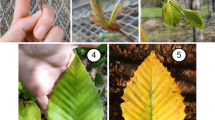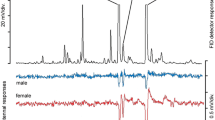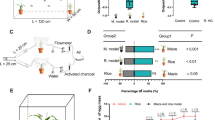Abstract
The role of the alkyl terminus of green leaf volatile (GLV) molecules in olfactory reception and inactivation was examined in three diverse insect species: the beet armyworm,Spodoptera exigua (Lepidoptera); the Colorado potato beetle,Leptinotarsa decemlineata (Coleoptera); and the desert locust,Schistocerca gregaria (Orthoptera), using selectively fluorinated analogs of GLVs and electroantennograms (EAGs). When only the magnitude of the depolarization of the EAG is considered (a measure of reception), the order of effectiveness was 1-hexanol (6:OH)=(Z)-3-6:OH > 5,5,6,6,6-pentafluoro-(Z)-3-6:OH =5,5-difluoro-(Z)-3-6:OH ≫ 5,5,6,6,6-pentafluoro-6: OH. Percent recovery of the EAG (a measure of inactivation) was greater for the pentafluoro-(Z)-3-6: OH analog than for the difluoro-(Z)-3-6: OH analog. Our results show that the alkyl end of GLV molecules plays an important role not only in reception, but also inactivation processes in insect olfaction. Furthermore, specificities of these two processes may differ.
Similar content being viewed by others
References
Bengtsson, M., Rauscher, S., Arn, H., Sun, W.-C., andPrestwich, G.D. 1990. Fluorinesubstituted pheromone components affect the behavior of the grape berry moth.Experientia 46:1211–1213.
Boeckh, J. 1967. Reaktionsschwelle, Arbeitsbereich und Spezifität eines Geruchsrezeptors auf der Heuschreckenantenne.Z. Vergl. Physiol. 55:378–406.
Dickens, J.C. 1989. Green leaf volatiles enhance aggregation pheromone of boll weevil,Anthonomus grandis Boh. (Coleoptera: Curculionidae).Entomol. Exp. Appl. 52:191–203.
Dickens, J.C., Jang, E.B., Light, D.M., andAlford, R.A. 1990. Enhancement of insect pheromone responses by green leaf volatiles.Naturwissenschaften 77:29–31.
Dickens, J.C., Prestwich, G.D., Sun, W.-C., andMori, K. 1991. Receptor site analysis using neurosensory responses of the boll weevil to analogs of the cyclohexylideneethanol of its aggregation pheromone.Chem. Senses 16:239–250.
Dickens, J.C.,Smith, J.W., andLight, D.M. 1993a. Green leaf volatiles enhance sex attractant pheromone of the tobacco budworm,Heliothis virescens (Fabr.) (Lepidoptera: Noctuidae).Chemoecology In press.
Dickens, J.C., Visser, J.H., andvan der Pers, J.N.C. 1993b. Detection and deactivation of pheromone and plant odor components by the beet army worm,Spodoptera exigua (Hübner) (Lepidoptera: Noctuidae).J. Insect Physiol. 39:503–516.
Duncan, D.B. 1955. Multiple range and multiple F tests.Biometrics 11:1–42.
Filler, R., andKobayashi, Y. (eds.). 1982. Biomedical Aspects of Fluorine Chemistry. Elsevier, Amsterdam. 246 pp.
Hansson, B.S., van der Pers, J.N.C., andLofqvist, J. 1989. Comparison of male and female olfactory cell response to pheromone compounds and plant volatiles in the turnip moth,Agrotis segetum.Physiol. Entomol. 14:147–155.
Kafka, W. 1971. Specificity of odor-molecule interaction in single cells, pp. 61–72,in G. Ohloff and A.F. Thomas (eds.). Gustation and Olfaction. Academic Press, New York.
Kaib, M. 1974. Die Fleisch- und Blumenduftrezeptoren auf den Antenne der SchmeissfliegeCalliphora vicina.J. Comp. Physiol. 95:105–121.
Kaissling, K.-E. 1987.in K. Colbow (ed.). R.H. Wright Lectures on Insect Olfaction. Typographischer Betrieb. W. Biering, H. Nurnberger, Munich. 75 pp.
Linn, C., Roelofs, W., Sun, W.-C., andPrestwich, G.D. 1992. Activity of perfluorobutylcontaining components in pheromone blend of cabbage looper moth,Trichoplusia ni. J. Chem. Ecol. 18:737–748.
Ma, W.-C., andVisser, J.H. 1978. Single unit analysis of odour quality coding by the olfactory antennal receptor system of the Colorado beetle.Entomol. Exp. Appl. 24:320–333.
McLean, J.A., Morgan, B., Sweeny, J.D., andWeiler, L. 1989. Behavior and survival of western spruce budworm,Choristoneura occidentalis Freeman, exposed to anα-fluorinated pheromone analog.J. Chem. Ecol. 15:91–103.
Ng, C.-S. 1991. Synthesis of fluorinated and radiolabelled pheromones. MS thesis. State University of New York, Stony Brook.
Ostle, B. 1963. Statistics in Research. Iowa State University Press, Ames, Iowa, xv + 585 pp.
Prestwich, G.D. 1993. Chemical studies of pheromone receptors in insects.Arch. Insect Biochem. Physiol. 22:75–86.
Prestwich, G.D., Sun, W.-C., Mayer, M.S., andDickens, J.C. 1990. Perfluorinated moth pheromones synthesis and electrophysiological activity.J. Chem. Ecol. 16:1761–1777.
Sass, H. 1976. Zur nervösen Codierung von Geruchsreizen beiPeriplaneta americana.J. Comp. Physiol. 107:48–65.
Sun, W.-C., andPrestwich, G.D. 1990. Partially fluorinated analogs of (Z)-9-dodecenyl acetate: Probes for pheromone hydrophobicity requirements.Tetrahedron Lett. 31:801–804.
Sun, W.-C., Ng, C.-S., andPrestwich, G.D. 1992. Synthesis of partially fluorinated analogues of (Z)-5-decenyl acetate: Probes for hydrophobic interaction in pheromone reception.J. Org. Chem. 57:132–137.
Visser, J.H. 1979. Electroantennogram responses of the Colorado beetle,Leptinotarsa decemlineata, to plant volatiles.Entomol. Exp. Appl. 25:86–97.
Visser, J.H. 1986. Host odor perception in phytophagous insects.Annu. Rev. Entomol. 31:121–144.
Visser, J.H., andAvé, D.A. 1978. General green leaf volatiles in the olfactory orientation of the Colorado beetle,Leptinotarsa decemlineata.Entomol. Exp. Appl. 24:538–549.
Visser, J.H., Van Straten, S., andMaarse, H. 1979. Isolation and identification of volatiles in the foliage of potato,Solanum tuberosum, a host plant of the Colorado beetle,Leptinotarsa decemlineata.J. Chem. Ecol. 5:13–25.
Vogt, R.G., andRiddiford, L.M. 1981. Pheromone binding and inactivation by moth antennae.Nature 293:161–163.
Whitman, D.W., andEller, F.J. 1990. Parasitic wasps orient to green leaf volatiles.Chemoecology 1:69–75.
Wu, W., Bengtsson, M., Hansson, B.S., Liljefors, T., Lofstedt, C., Prestwich, G.D., Sun, W.-C., andSvensson, M. 1993. The electrophysiological and behavioural response of turnip moth males,Agrotis segetum, to fluorinated pheromone analogues.J. Chem. Ecol. 19:143–157.
Author information
Authors and Affiliations
Additional information
Research conducted by J.C.D. while on an ARS Fellowship at IPO-DLO.
Rights and permissions
About this article
Cite this article
Dickens, J.C., Prestwich, G.D., Ng, C.S. et al. Selectively fluorinated analogs reveal differential olfactory reception and inactivation of green leaf volatiles in insects. J Chem Ecol 19, 1981–1991 (1993). https://doi.org/10.1007/BF00983801
Received:
Accepted:
Issue Date:
DOI: https://doi.org/10.1007/BF00983801




